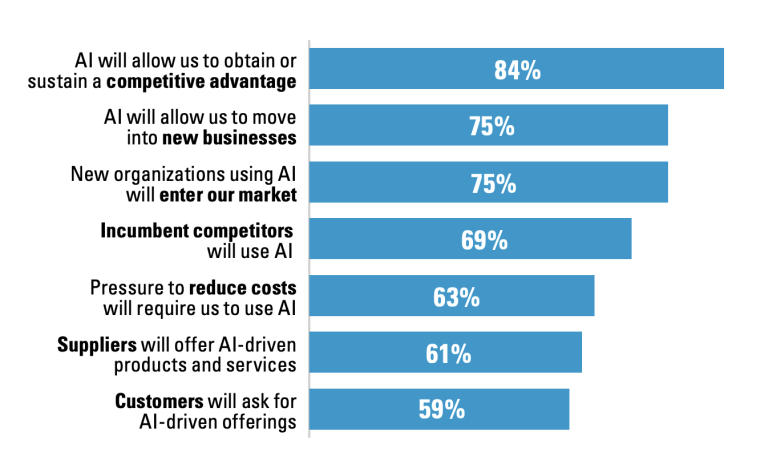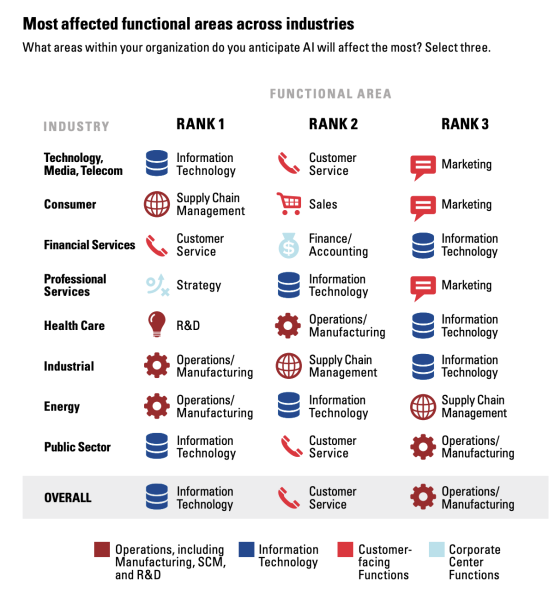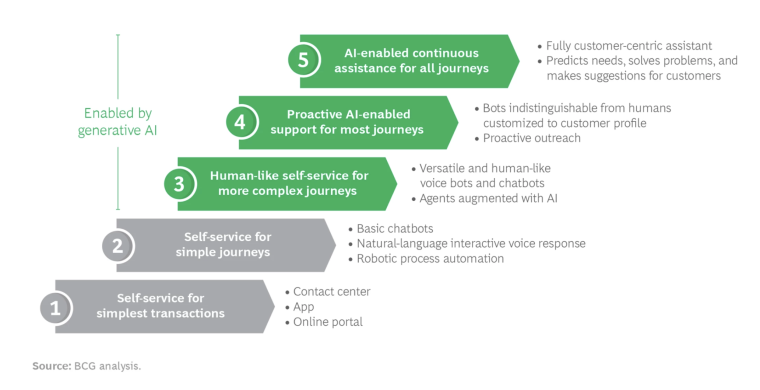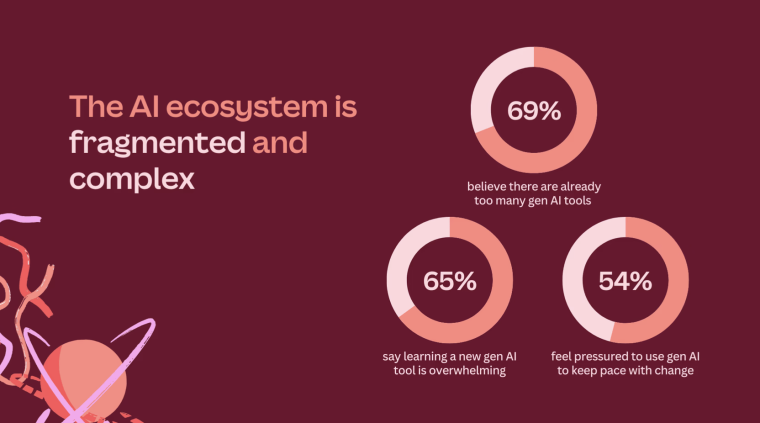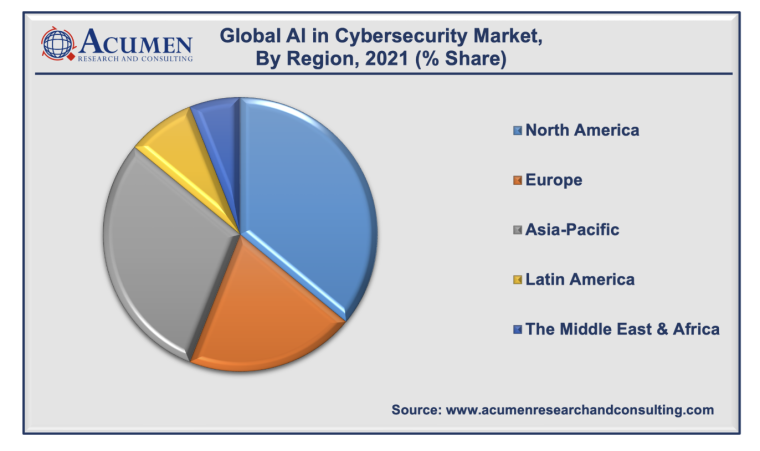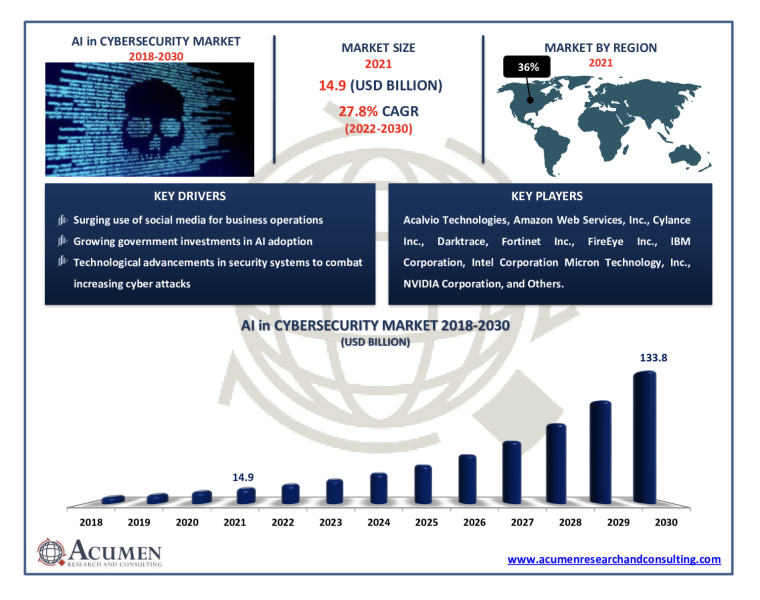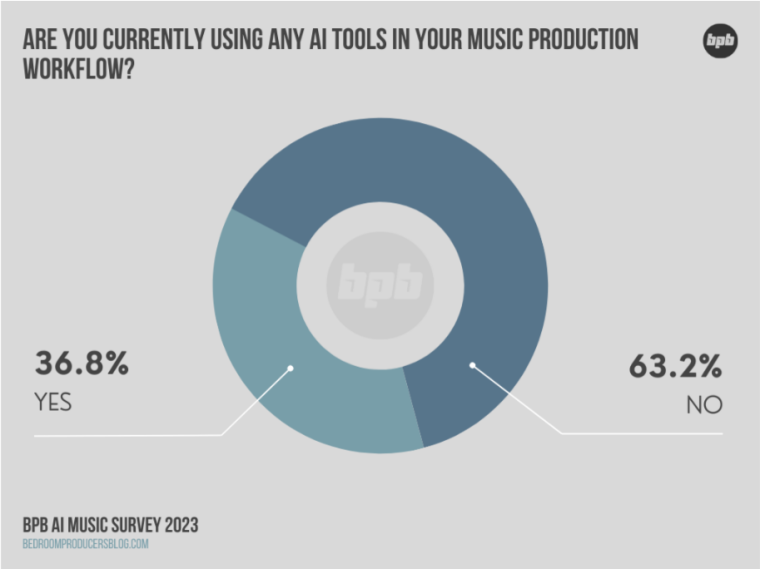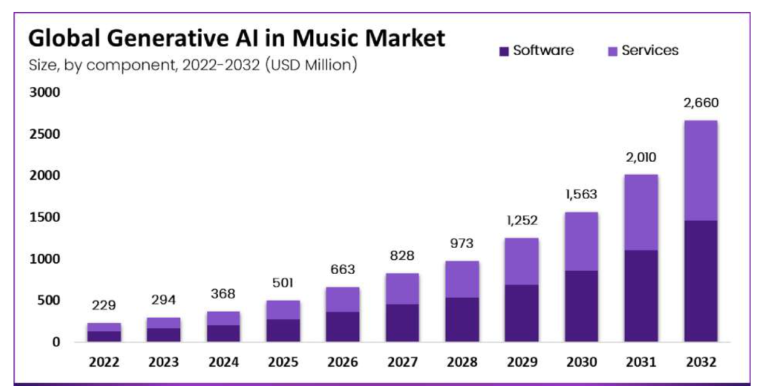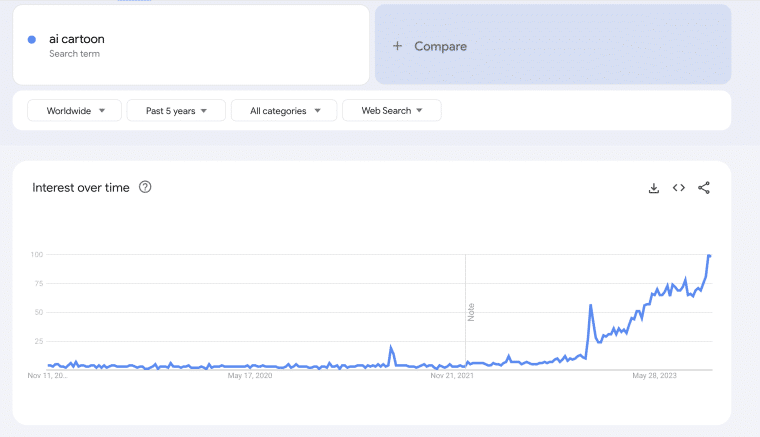Artificial intelligence (AI) has transformed many industries in ways unimaginable just a few years ago. Using AI technologies effectively can bring a range of benefits to your business, such as increasing output levels at lower costs, shortening production time, creating innovative products, and more.
Here at Business2Community, we’re committed to providing you with the most reliable, valuable, and timely information sourced from credible organizations. In this article, we’ll go deep into the 8 most valuable AI trends in 2025 so you can gain a better understanding of how you can utilize them to develop your business.
Key AI Trends
- In 2022, 35% of companies worldwide had adopted AI in their operations.
- The top 3 affected functional areas because of AI are information technology, customer service, and operations/manufacturing.
- In 2020, 75% of business leaders regarded AI as a crucial part of their operations.
- Generative AI tools are expected to bring up productivity by 30% to 50%.
- In 2022, 62% of executives believed enforcing AI regulation is necessary.
What are 2025’s AI Trends?
Artificial intelligence has created a paradigm shift in the workforce and operation flows. To stay on top of the game, you need to reevaluate your strategies to reap the most from these trends.
According to McKinsey, the average number of AI capabilities used by businesses was 1.9 in 2018. In 2022, the number had risen to 3.8, although that’s slightly lower than the year before at 3.9.
The top three capabilities used were robotic process automation, computer vision, and natural language processing, respectively.
84% of businesses believed AI could give them a competitive advantage in their fields while 75% believed it could open doors to new businesses. Furthermore, 75% also saw the need to adopt AI because new competitors entering their markets would be utilizing it as well.
As a 2017 BCG report revealed, AI had already penetrated almost every sector, particularly those working in tech, customer service, and operations.
With AI adjusting the flow of the global economy and taking up more important roles in commerce, it’s time to master the current trends so you don’t miss out on the potential gains. Let’s take a look at the most groundbreaking AI trends in 2025.
1. AI in Customer Services
Ever since OpenAI‘s ChatGPT was launched in the fall of 2022, companies have been exploring how text-based generative AI can enhance the customer service experience. According to a report by BCG in 2022, 95% of global customer service leaders expected AI assistants to be involved in customer interactions within the next three years.
In a comprehensive IBM survey in 2022, it was revealed that 38% of businesses were already using natural language processing (NLP) within their customer care function. 48% of respondents also said they were using AI to deliver a better experience for their customers.
The adoption of generative AI tools could bring up productivity by 30% to 50%, which is a massive incentive for business owners to explore this avenue. Digital humans that can comprehend human language can effectively reduce the average waiting time for customers and handle a larger volume of commands at once, compared to human agents.
The BCG study classed AI-enabled customer service into 5 stages and asserted that the world would achieve stage 3 standards soon. It predicts that the natural language processing used in AI assistants would be able to handle more commands in different formats. Meanwhile, digital twins can also be used to simulate scenarios to train customer service teams.
By stage 5, AI advancements are expected to:
- Support every user journey.
- Customize solutions for individual customer’s needs.
- Act as a personal assistant to nurture customer relationships with the company.
- Use sentiment analysis to anticipate customers’ concerns and needs.
- Interact with other generative AI applications to formulate a well-rounded look into the customer’s consumption habits.
Large language models can train AI assistants and analyze large data sets efficiently, thus offering the most personalized care and delivering customized ads to users. Business owners can then utilize these AI models to ensure satisfactory service standards and target the right consumer pool.
In the near future, more companies are likely to integrate AI into their operations to provide 24/7 care. It is a fantastic way to expand your reach and improve the quality of services.
2. Generative AI in Graphic Design
Generative AI programs like Adobe, DALL-E 2, and Midjourney have transformed the graphic design industry. Indeed, a Hubspot report noted that 93% of web designers had already used AI tools in their processes.
Synthetic media is becoming more popular as a lot of AI-assisted tools are free of charge, allowing small business owners to produce logos, promotional materials, and design websites at a fraction of the traditional cost.
These image generators provide startups with a limited budget to scale up their business operations without a huge price tag. SaaS Worthy notes that the average price for an AI image generator is only around $19.99 per month, making the powerful tools incredibly accessible.
Nick Hill of Re Design called 2022 the “edge of a design tool nirvana”. Through machine learning, prompt engineers can generate complicated images in minutes that would traditionally have taken artists hours to produce.
Incorporating digital tools into content creation allows artists to innovate their products and increase outputs.
Leading graphic design platform Canva surveyed over 4,000 creative leaders in the US, UK, Australia, France, Germany, Spain, Brazil, Mexico, and India, to identify the role of AI in content creation.
- Key findings in the survey included:
- 69% believe generative AI could increase creativity
- 82% used AI tools to create images for their businesses
- 49% believed AI-generated images would be better than human work
However, the complex and competitive nature of the AI market also brought concerns for professionals:
- 69% said there was an overload of existing AI tools
- 65% were overwhelmed by the learning curve of new AI software
- 54% felt pressured to keep up with current AI trends
Furthermore, data governance was another major concern. Over 70% of creatives were worried about AI-powered tools breaching privacy on sensitive data like company information and personal details with the use of tools like digital twins. They also expressed concerns about AI bias in the content generation process.
3. AI in Cybersecurity
AI in cybersecurity refers to AI-powered solutions that analyze existing data to detect security breaches within the company. IBM’s 2023 survey found that only 28% of organizations it asked were actively implementing AI in their cybersecurity practices.
According to research conducted by the nonprofit impact investment fund, Acumen, the AI cybersecurity market was valued at $14.9 billion in 2021. The number is set to exceed $133.8 billion by 2030.
North America currently has the biggest AI cybersecurity market in the world, comprising 36% of the total market share.
Following the rapid pace of technological advancements, both hackers and businesses are racing to get the upper hand in the digital security game. Adopting AI into your cybersecurity strategies is essential to fight against the growing threats.
There is a rising demand for cloud-based security services among SMEs. Business owners are embracing this new way to safeguard their data.
Data science giants like IBM and AWS provide AI cybersecurity solutions to combat online threats and attacks. These solutions can:
- Identify attack patterns through machine learning
- Enhance the accuracy of threat detection
- Protect user identities and data
- Customize AI models for individual customers
- Report to and update human cybersecurity teams about potential risks
- Simulate online attacks to train cybersecurity teams
4. AI in Music
Over the years, AI’s impact on the creative industries has been increasingly significant. Software like OpenAI, Soundful, AIVA, and Boomy help musicians and music producers with a low budget to produce high-quality soundtracks.
In a survey of 1,500 music producers in 2023 by Bedroom Producers Blog, over 36% were already using AI in their work, while a further 30% were planning on using it soon. Another survey, this time by Ditto Music, puts the number at 59.5% of artists currently using AI in music with 28.5% saying they’d never consider using such tools.
A report published by Market US revealed the potential of AI-generated music. The market value was estimated to be $229 million in 2022. The value is set to exceed $2.66 billion by 2032.
There are a range of ways that AI can be applied to music production, with some the most common tools being:
- AI mixing and mastering tools
- AI music generators
- AI drum programming tools
- AI sound design tools
- AI voice changing tools
Here’s how their use breaks down across industry professionals:
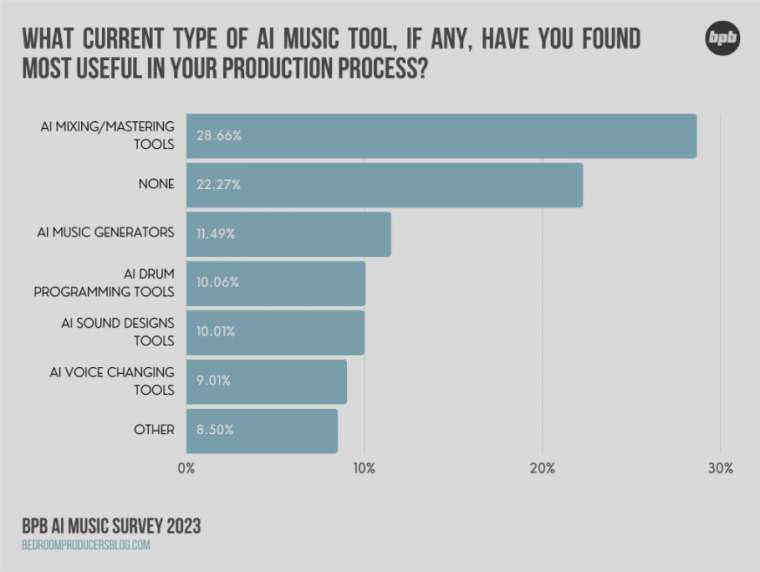
In the same survey, it was found that nearly half of producers had a neutral stance on the use of AI in their industry. However, the biggest concern expressed was that AI would strip out creativity and originality from the industry. Other concerns included ethical issues and the reduction in employment opportunities.
Only 8.75% of producer think that AI can’t help them in their workflows, showing that the technology is going to be used across the industry in different ways to streamline music production and even unleash creativity with repetitive tasks such as drum programming being taken care of.
5. AI in Healthcare
AI has become a part of everyday life and when it comes to healthcare, it’s powering groundbreaking advances that are already saving lives, reducing costs, and enhancing efficiency. In a small survey of 500 healthcare professionals in the US, over 10% were already implementing AI in some way and nearly half were keen to bring these technologies into their future practice.
The Health Management Academy in 2023 estimated that 47.5% of health systems in the US were using AI as a way to combat their staff shortages. Meanwhile, NLP is being used by 27.5% of systems and 15% are using it within their nursing services.
According to Statista, the global artificial intelligence healthcare market was valued at $11 billion in 2021. By 2030, the number is estimated to be $188 billion, representing a CAGR of 37%.
- Maximize Market Research broke down the major uses of AI in healthcare:
- Use digital twins to assist in more accurate diagnosis and medical imaging
- Drug development and drug discovery
- Use predictive AI technology for early detection and predictive analytics
- Personalized medicine
- Automate the administrative process to reduce the chances of human errors
- Monitor patients remotely and send live alerts to healthcare professionals
- Use natural language processing to better understand patients’ needs and give timely responses
- Identify emergencies with computer vision
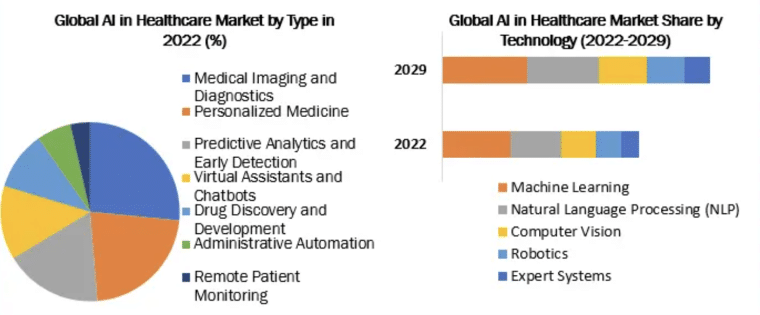
Healthcare professionals with advanced knowledge of the AI space will get an edge in the field as hospitals are desiring talents who can work with and understand these new technologies.
The University of Hawaiʻi Cancer Center has started utilizing the deep learning model to conduct risk assessment for breast cancer to improve early detection rates. After analyzing 25,000 scans, the foundation models constructed were able to increase the accuracy in identifying risk factors.

Aside from improving the quality of life for humans, the AI sector is also revolutionizing the veterinarian world. A Tokyo-based company, Carelogy Inc., partnered with Nihon University to launch a pain detection app to assist owners and vets in assessing the pain level of cats.

The tool takes on the role of ranking pain levels that would be traditionally performed by vets to standardize service quality. Similar apps worldwide are helping vets diagnose pets, farm animals, and wild animals that would be typically difficult to examine.
6. Innovative AI Models in Aviation
Aviation security and efficiency have always been a hot topic. With the introduction of AI in the aviation space, airlines can enhance the safety level and manage costs effectively.
Market Research Future put a value of $113.29 million on the AI in the aviation market in 2022, with an expectation for a CAGR of 39.1%. This means the value of the market should reach $5.47 billion by 2030.
AI in aviation can:
- Use a multimodal model to quickly identify parts of a carrier for safety checks and defect detection
- Use digital twins to simulate passenger flows to locate possible security threats and enhance the overall passenger experience
- Optimize flight planning, flight deployments, and ground operations
- Speed up the onboarding process
- Facilitate the development of new models and designs by running them through simulations
Developers and workers in the airspace field will be able to simplify every process to focus on high-value-added tasks.
SWISS, part of Lufthansa Group, partnered with Google Cloud in 2023 to optimize 50% of its network flights with computer vision.
Here are the achievements following the optimization:
- $1.1 million (1 million CHF) saved over 14 weeks.
- Used computer vision to onboard passengers to enhance security and efficiency.
- Reduced fuel consumption and carbon footprint.
- Automated the customer support process to standardize service quality and allocate human workers to higher value-added tasks.
- Enhanced the user experience by reducing miscommunication risks.
7. Investment and Growth of AI Tools
As technologies have matured over the better half of the last decade, businesses have continuously increased their budget for developing AI systems.
The IBM AI Global Adoption Index 2022 stated that 35% of companies worldwide have adopted artificial intelligence in their operations and 42% are exploring the possibility of it.
Meanwhile, a survey conducted by the Deloitte AI Institute revealed that, in 2020, 75% of business leaders regarded AI as a critical part of their operations. Among these companies, over 50% spent more than $20 million on AI technologies.
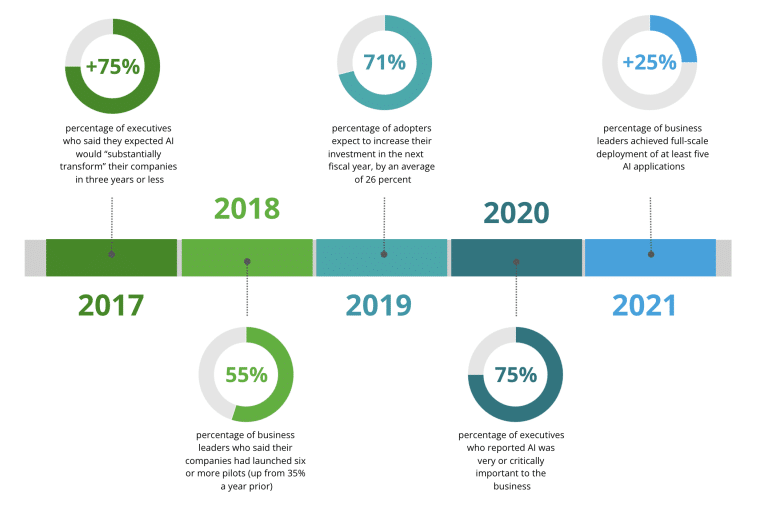
By 2021, 25% of companies had attained at least 5 full-scale AI applications.
With 37% of businesses having an AI strategy in place, according to IBM in 2022, the automotive, aerospace, and chemical, oils and gas industries are leading the charge in investing in reskilling their people to take on the new challenges presented.
8. Ethics of Artificial Intelligence
With the rise of artificial intelligence, there are growing concerns among AI ethicists and stakeholders about how the new era can lead to catastrophe. 2025 could be the inflection point of AI.
Google DeepMind co-founder, Mustafa Suleyman, said in a Washington Post Live that he feared “AI could potentially get good at teaching somebody how to make a bomb, or how to manufacture a biological weapon”.
To make sure humans see the upsides of it rather than the dark side, he believed that “We need regulators to be technical and proactive and competent”.
More than 50% of companies slowed down or even halted AI adoption due to ethical risks and negative public perceptions, while 57% reported to IBM that they have ethics concerns about the technology.
Without any legal framework or AI regulation, companies are beginning to fear the negative public perception of using AI.
The 2023 writer and actor strikes in the USA reflect workers’ fear of how these emerging technologies would threaten job opportunities. Industry leaders are urging policymakers to regulate AI to safeguard human jobs.
Governments around the world have expressed intentions or formulated solid plans to implement and monitor the AI industry to protect workers’ benefits.
Although 62% of executives believed in enforcing tighter AI regulation, roughly the same population agreed that it would limit AI growth and innovation.
How to Find AI Trends
1. Online Trends Data
Paying attention to the trends that affect your business is a smart way to stay competitive.
For example, if you’re the head developer of a media house, you’ll want to know people’s interest in keywords like AI-generated films to be aware of public perception and know what trending content to produce.
Sites like Google Trends and Ahrefs are excellent ways to keep up with AI trends. They record and summarize different data types into charts so you can easily use them in your next business presentation.
You can even customize the time period and region for more relevant results. If you don’t have specific keywords in mind, you can also browse around to see what are some trending keywords in the industry.
2. Research and Reports
Leading marketing and consulting firms like McKinsey, Deloitte, and Pew Research Center regularly publish reports on the latest business trends in fields such as AI.
They conduct surveys and deep analysis to see how the AI revolution is reshaping the commercial sector.
Whether you’re simply interested in emerging technologies like quantum AI or want to integrate AI into your operations, following these market research giants ensures that you’ll receive the latest updates.
3. Newspapers and Podcasts
Publications like OpenAI’s blog and Business2Community are useful outlets for sourcing your next big profitable idea. They find trending topics in technology like computer vision applications, generative AI breakthroughs, explainable AI in business, etc.
By studying these trends, tech workers and business owners can utilize them to reap bigger profits.
If you’re not much of a reader, the AI in Business Podcast will come in handy during your morning car ride to work. It’s a weekly podcast where the founder of Emerj, Daniel Faggella, interviews top industry leaders and executives to discuss business applications of technologies.
The Future of AI
As global businesses have seen the benefits of incorporating AI into their operations, it’s expected that more and more companies will expand their AI applications in the future.
Here are a few things to expect from the future of AI:
- Fully automated manufacturing processes
- Wider use of computer vision to monitor public safety and prevent crimes
- Personal intelligence that understands the human language and can be controlled by the mind to complete tasks like online shopping
- Full AI democratization for non-tech workers to create apps and systems for their businesses
- Perfecting digital twin technology to simulate human activities and minds with high levels of accuracy
New technologies will continue to have far-reaching implications in our daily lives. Understanding the trends will allow you to build smarter and more profitable marketing and operational strategies.
If you’re planning to expand your business scope or find new opportunities in your field, now is the best time to join the AI-led world and build your business model around it.


